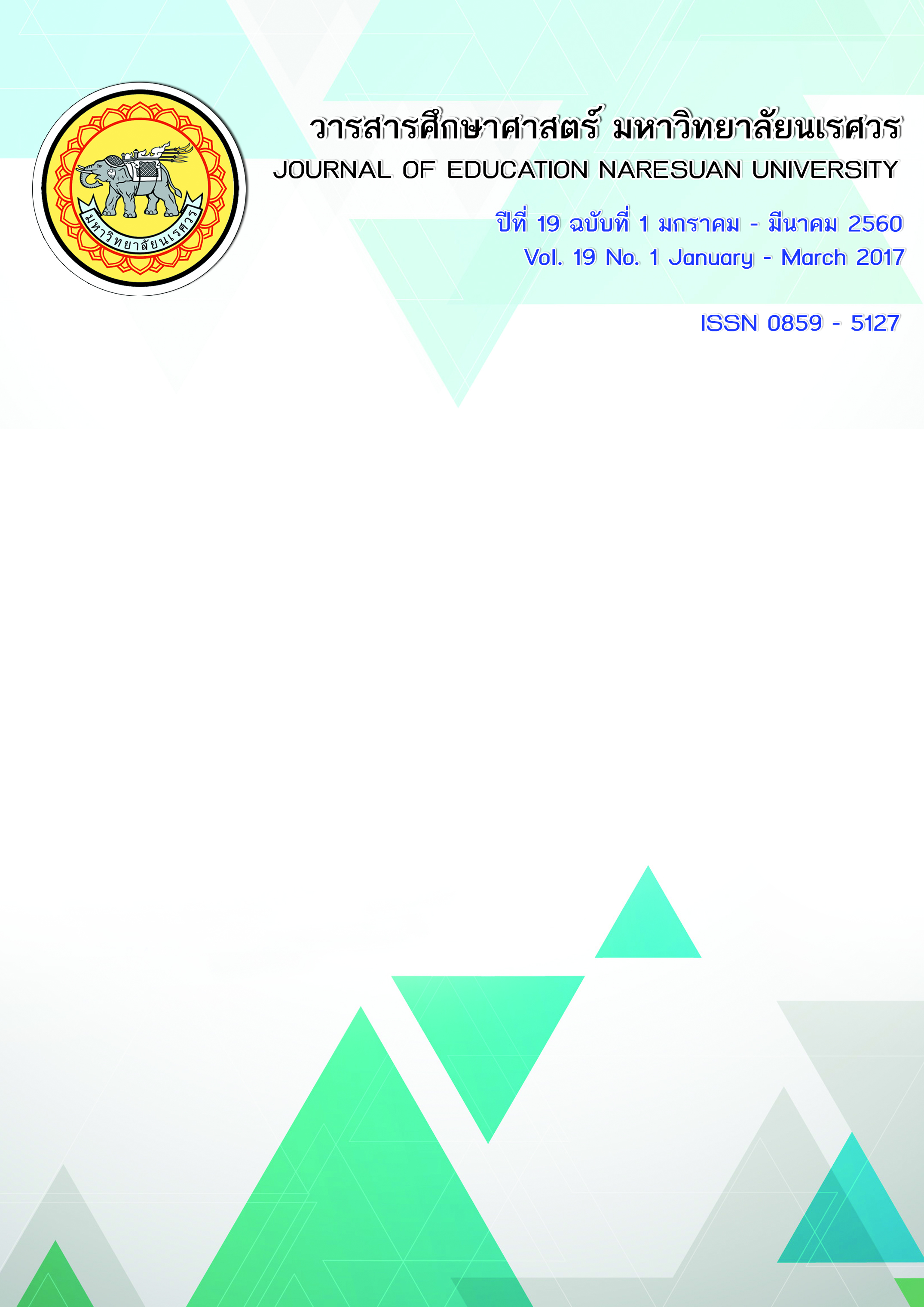การพัฒนารูปแบบกิจกรรมการเรียนรู้ตามทฤษฎีการพิพาทเชิงสร้างสรรค์ เพื่อสร้างเสริมความเป็นพลเมืองในประชาคมอาเซียนสำหรับนักเรียนระดับมัธยมศึกษาตอนปลาย
Main Article Content
Abstract
การวิจัยครั้งนี้มีวัตถุประสงค์คือ 1) เพื่อศึกษาข้อมูลพื้นฐานความเป็นพลเมืองในประชาคมอาเซียน 2) เพื่อสร้างและตรวจสอบคุณภาพของรูปแบบกิจกรรมการเรียนรู้ตามทฤษฎีการพิพาทเชิงสร้างสรรค์ 3) เพื่อศึกษาผลการใช้รูปแบบกิจกรรมการเรียนรู้ฯ และ 4) เพื่อศึกษาความพึงพอใจต่อการเรียนด้วยรูปแบบกิจกรรมการเรียนรู้ฯ ดำเนินการวิจัยด้วย
4 ขั้นตอน ได้แก่ 1) การศึกษาข้อมูลพื้นฐานในการพัฒนารูปแบบกิจกรรมการเรียนรู้ฯ 2) การสร้างและหาคุณภาพของรูปแบบกิจกรรมการเรียนรู้ฯ 3) การศึกษาผลการใช้รูปแบบกิจกรรมการเรียนรู้ฯ 4) การศึกษาความพึงพอใจในการเรียนโดยใช้รูปแบบกิจกรรมการเรียนรู้ฯ กลุ่มตัวอย่างเป็นนักเรียนชั้นมัธยมศึกษาปีที่ 5 โรงเรียนสาธุกิจประชาสรรค์ รัชมังคลาภิเษก สังกัดสำนักงานเขตพื้นที่การศึกษามัธยมศึกษา เขต 37 ในภาคเรียนที่ 2 ปีการศึกษา 2557 เครื่องมือที่ใช้ในการวิจัย ได้แก่ 1) แบบวัดความรู้เกี่ยวกับประชาคมอาเซียน มีค่าอำนาจจำแนกตั้งแต่ .21 - .78 และมีค่าความเที่ยงเท่ากับ .92 2) แบบประเมินทักษะของความเป็นพลเมืองในประชาคมอาเซียนกำหนดเกณฑ์คุณภาพการให้คะแนนแบบรูบริค มีค่าความเที่ยง .90 3) แบบประเมินเจตคติของความเป็นพลเมืองในประชาคมอาเซียนมีค่าความเชื่อมั่น .80
4) แบบรายงานความพึงพอใจของนักเรียนที่มีต่อรูปแบบกิจกรรมการเรียนรู้ฯ มีค่าความเชื่อมั่น 0.80 ผลการวิจัย พบว่า
1. แนวคิดการจัดกิจกรรมความเป็นพลเมืองในประชาคมอาเซียนควรจัดกิจกรรมเน้นบูรณาการการเรียนรู้อยู่ร่วมกันในสังคมที่หลากหลาย สร้างทักษะ ความรู้ เน้นการฝึกปฏิบัติจริง พัฒนาทักษะต่างๆ ในศตวรรษที่ 21 ทั้งทักษะการสื่อสาร ทักษะแก้ปัญหา ทักษะชีวิต ทักษะการใช้เทคโนโลยี ส่งเสริมคุณลักษณะความรับผิดชอบ ลักษณะสำคัญของความเป็นพลเมืองในประชาคมอาเซียน คือ 1) มีความรู้เกี่ยวกับประเทศตนเอง เกี่ยวกับประเทศต่างๆ ในอาเซียน ความรู้เกี่ยวกับวิถีชีวิต สภาพภูมิประเทศ ความเชื่อและการดำรงชีวิตของประเทศในอาเซียน และอัตลักษณ์ร่วมกันของอาเซียน
2) มีทักษะต่างๆ 3) มีเจตคติในเรื่องความสามัคคี มีความรับผิดชอบต่อตนเองและต่อสังคมที่ตนเองอาศัยอยู่ ทิศทางการจัดการศึกษาเพื่อสร้างความเป็นพลเมืองในประชาคมอาเซียน มีการบูรณาการองค์ความรู้และเรียนรู้ตลอดชีวิตแบบไร้พรมแดน มุ่งเน้นการสื่อสารและความร่วมมือพัฒนาที่ยั่งยืน การร่วมมือกันในการสร้างและพัฒนากระบวนการเรียนการสอนร่วมกันในประชาคมอาเซียน เรียนรู้จากสังคม ปัจจัยพื้นฐานที่ทำให้ที่ทำให้สำเร็จในการส่งเสริมความเป็นพลเมืองในประชาคมอาเซียน ผู้เกี่ยวข้องเป็นผู้มีบทบาทสำคัญยิ่งในการเตรียมการ การเป็นตัวแบบการจัดกิจกรรม ให้คำแนะนำ กระตุ้นการคิด
2. รูปแบบกิจกรรมการเรียนรู้ตามทฤษฎีการพิพาทเชิงสร้างสรรค์เพื่อสร้างเสริมความเป็นพลเมืองในประชาคมอาเซียน สำหรับนักเรียนระดับมัธยมศึกษาตอนปลาย มี 7 องค์ประกอบ ได้แก่ 1) ความเป็นมาของรูปแบบ 2) แนวคิดพื้นฐานในการพัฒนารูปแบบกิจกรรม 3) หลักการ 4) วัตถุประสงค์ 5) การวัดและประเมินผล 6) กระบวนการจัดกิจกรรม
7) โครงสร้างและเนื้อหารูปแบบกิจกรรม โดยมีกระบวนการ 5 ขั้นตอน (PCDCD) ได้แก่ ขั้นที่ 1 ให้กรณีศึกษาหรือปัญหา (Problem Based) ขั้นที่ 2 การค้นหาข้อมูลด้วยตนเอง (Concurrence Seeking) ขั้นที่ 3 การอภิปรายในบทบาทฝ่ายเสนอและฝ่ายค้าน (Debate) ขั้นที่ 4 การสลับบทบาทอีกครั้งหนึ่ง (Change positions) ขั้นที่ 5 การร่วมกันสรุปเป็นคำตอบ (Draw conclusion) ผลการตรวจสอบจากผู้เชี่ยวชาญพบว่า รูปแบบกิจกรรมมีความเหมาะสมในระดับมากและมีความสอดคล้องในทุกองค์ประกอบ และผลการทดลองนำร่อง พบว่า มีความเหมาะสมนำไปใช้จัดกิจกรรมได้
3. นักเรียนมีความเป็นพลเมืองในประชาคมอาเซียนหลังร่วมกิจกรรมสูงกว่าก่อนร่วมกิจกรรมตามรูปแบบที่พัฒนาขึ้น โดย 1) นักเรียนมีความรู้เกี่ยวกับประชาคมอาเซียนหลังเข้าร่วมกิจกรรมสูงกว่าก่อนเข้าร่วมกิจกรรมอย่างมีนัยสำคัญสถิติที่ระดับ .01 2) นักเรียนมีทักษะความเป็นพลเมืองในประชาคมอาเซียนหลังเข้าร่วมกิจกรรมสูงกว่าเกณฑ์ร้อยละ 75 อย่างมีนัยสำคัญสถิติที่ระดับ .01 3) นักเรียนมีเจตคติต่อการร่วมกิจกรรมตามรูปแบบกิจกรรมการเรียนรู้ที่พัฒนาขึ้นหลังเข้าร่วมกิจกรรมสูงกว่าก่อนเข้าร่วมกิจกรรมอย่างมีนัยสำคัญสถิติที่ระดับ .01
4. ความพึงพอใจของนักเรียนต่อการเรียนตามรูปแบบกิจกรรมการเรียนรู้ฯที่พัฒนาขึ้นในระดับมาก
A DEVELOPMENT OF LEARNING ACTIVITY MODEL BASED ON CONSTRUCTIVE CONTROVERSY THEORY TO ENHANCE ASEAN CITIZENSHIP FOR HIGH SCHOOL STUDENTS
The purpose of this study were to 1) study fundamental data needed to develop a Learning Activity Model Based on Constructive Controversy Theory to Enhance ASEAN Citizenship Characters for high school students, 2) Construct and meet a quality of Learning activity Model Based on Constructive Controversy Theory, 3) the Learning Activity Model Based on Constructive Controversy Theory, and 4) study the students’ s satisfaction towards the activity model based on Constructive Controversy Theory. Research methodology was research and development in four stages in this Process are; Stage 1 – study fundamental data about desired ASEAN Citizenship Characters needed to enhance ASEAN Citizenship Characters for high school students. Stage 2 – constructed and validated the activity model. Stage 3 – have the activity model experimented with 23 High school students from Sathukit Prachasan Ratchamongklaphisek School and stage 4 - assess the students’s satisfaction toward on activity model based on constructive controversy theory to enhance ASEAN citizenship characters in 3 factors. The research instruments were
1) Acknowledge test, that had index of congruence at .28 - .78 and reliability at .92,
2) ASEAN citizenship characters test that had index of congruence at 1.0 and reliability at .90, 3) An test towards ASEAN citizenship test that had reliability at .80, and 4) Students satisfaction form of toward the activities of activity model that had reliability at .80.
The finding were as follows:
1. Concept of ASEAN citizenship characters activity for high school students were Integrated learning living together in learning wide varieties of society to 21st century skills in knowledge, skill and practice. like communication, Information Technology, to promote the problem solve, life skill, responsibility and ASEAN citizenship characters skills; three aspects of desired ASEAN citizenship characters needed enhance ASEAN citizenship characters for high school students are 1) ASEAN citizenship characters knowledge promoted by providing ASEAN knowledge 2) ASEAN citizenship characters skills; working with other skill, diversity acceptation skills, discuss and sharing idea skill, problem solving by using critical thinking skill, and 3) unity attitude in self-responsibility. This educational trend to support the developing of ASEAN citizenship responsibility attitude can be promoted by providing a Leaning activity model based on constructive controversy of knowledge, and long life learning, communication, Collaborative for communication for sustainable development, global for basic factor these helped for success and enhance ASEAN citizenship characters; stakeholders were very important those help for in preparing of lessons, consulting, enhance thinking.
2. The Learning activity model based on constructive controversy theory to enhance ASEAN Citizenship Characters for high school students consists of 7 factors; 1) background,
2) knowledge of model fundamental concepts in a model development, 3) principles,
4) objectives, 5) evaluation, 6) activity process, and 7) structure and content of activity model. The 5-stage process (PCDCD) was applied to these factors consist of important activities: stage 1 - Problem based; stage 2 - Concurrence Seeking; stage 3 - Debate stage 4 - Change positions; stage 5 - Draw conclusion. The expert quality exam showed that the activity model developed by the researcher was appropriate and feasible.
3. High school students have ASEAN Citizenship after learned with model developed were higher than before as follows: 1) High school students’ knowledge were higher than before at Significance of .01 level. 2) High school students’ ASEAN Citizenship Characters’ skills after participation in the activities were higher than that of the set criteria up to 75% at significance of .01 level. 3) High school students’ attitude towards a learning form activity model developed after participation in the activities were higher than before at significant level of .01 level.
4. High school students satisfaction from towards participation in the activities of this model developed was at high level.
Article Details
The owner of the article does not copy or violate any of its copyright. If any copyright infringement occurs or prosecution, in any case, the Editorial Board is not involved in all the rights to the owner of the article to be performed.


